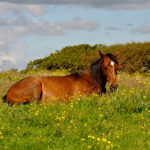On Wednesday, June 10, I got up and started driving north and west of Galway to Kylemore Abbey. It is a 19th century manor that was converted into an abbey for displaced monks from Ypres, Belgium. The abbey is etched in my mind as an archetypal image of Ireland, because my mother had a jigsaw puzzle of the abbey, which I still have. My mother loved the beauty of this place.
On the way, I was listening to Marilynne Robinson’s novel Gilead. I had the privilege of meeting Ms. Robinson at the Calvin Conference in Geneva just a few weeks ago, where she listened to the paper I gave. Gilead is a moving story, and for me, quite sad. It’s the kind of story that has been reminding me that what is important in my life is not what I put most time and effort into. It made me feel melancholy—an emotion that seems to be contagious here in Ireland. There is always pain and loss behind the smiles and laughs of the people here (who, by the way, are very hospitable and a joy to experience.) So when I saw Kylemore Abbey with my own eyes, I thought of my mother—which is something that I don’t often do. I don’t think about things that are painful.
But seeing this place forced me to remember. I walked around the main building (they allow you only a small view of it), then went outside to see the miniature gothic church. There I sat on a pew, surrounded by tourists who had no respect for a place of worship. I shut them out of my head and prayed. I prayed because it occurred to me that my mother’s fears are my own, and her shortcomings, her faults, her loneliness, her insecurities. In that little church I prayed, with German tourists milling around snapping photographs. And I felt the loss of my mother, which I have not allowed myself to feel for the past 14 years since she died.
I walked to the mausoleum of the woman who first lived in Kylemore when it was a manor, a castle of sorts. Her husband had built the miniature church in her memory, because she died young, at 45. Then I went to the walled gardens, which my mother would have loved. And I got in the car and drove to my next destination. And I wept. For the first time in a long time, I wept for my mother. My eyes welled up with tears, and I felt the grief, the loss, the regret.
I drove through the twisty, windy, sheep-strewn ribbons of asphalt they call roads here in the Irish countryside. The tears ebbed and ceased, and I felt that something very important had happened for me. I had honored my mother with my tears.
Murrisk
North of Kylemore Abbey I came across Louisburgh, which was the home base of sixteenth-century pirate queen Grace O’Malley, who could theoretically be a relative of mine. She was married to an O’Flaherty, the name of my ancestors. Down the road is Murrisk, where I saw three important things: Murrisk Abbey, a ruined church on the western Irish shore; Croagh Patrick (the Hill of Patrick), a site of pilgrimage, from which Patrick banished all the snakes from Ireland (not a huge challenge as miracles go, since there weren’t any snakes here to begin with); and the National Famine Monument, which depicts a coffin ship, one of the boats on which so many thousands of sick and starving Irish people sought relief and a new start in Ireland during the Great Famine, 1845-49. Many thousands died on those ships, more died soon after arriving in the USA and Canada. The monument depicts a ship of skeletons. It’s ghastly, but a fitting monument to the unspeakable horror of these people, whom the British government allowed to starve.
- Kylemore Abbey
- Kylemore Abbey
- Miniature Gothic Church, Kylemore Abbey
- Aasleigh Falls, Connemara, Ireland
- Beautiful scene of the sea and mountains in Connemara, western Ireland
- Horses grazing by the seaside, Connemara, western Ireland
- National Famine Memorial, Murrisk, County Mayo, Ireland
- The famine memorial is a “coffin ship,” representing ships on which starving Irish fled the country, many dying on the way
- The ship’s rigging is actually human skeletons, representing the famine dead.
- Lots of beautiful horses in Connemara











